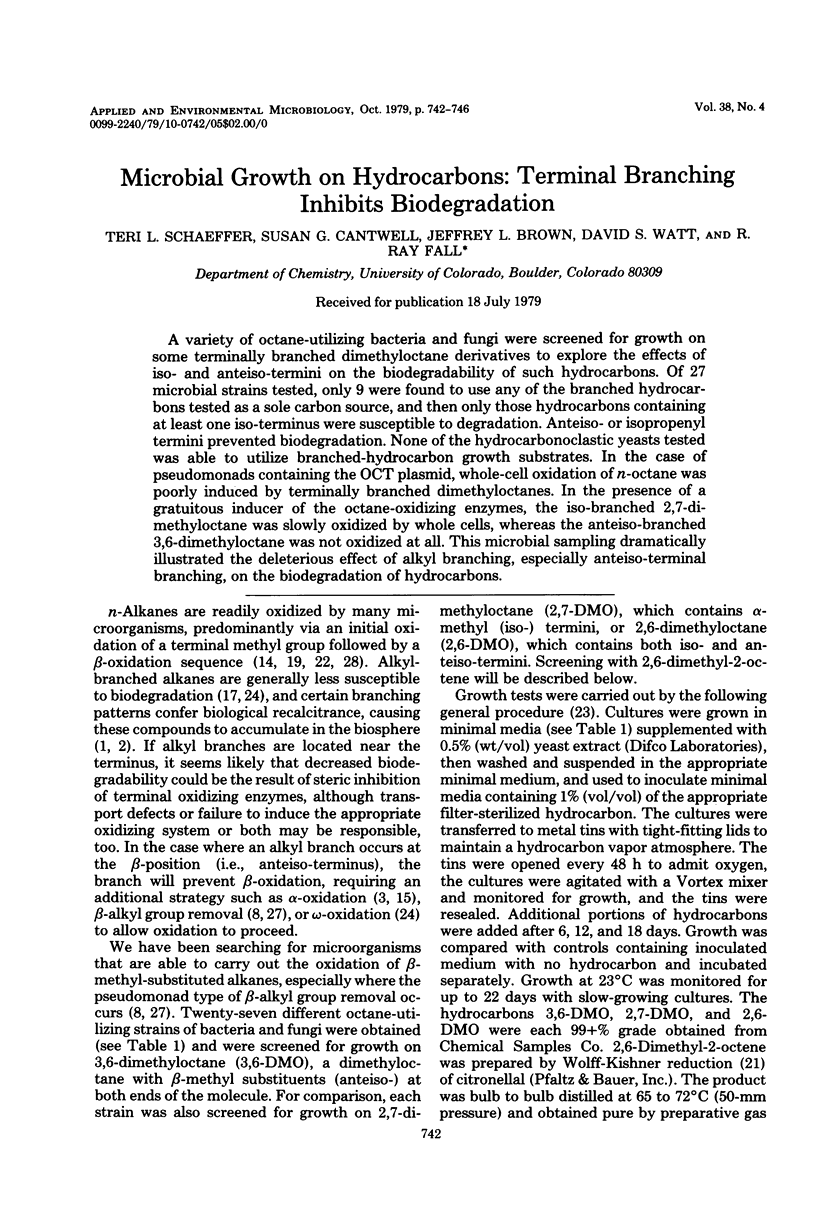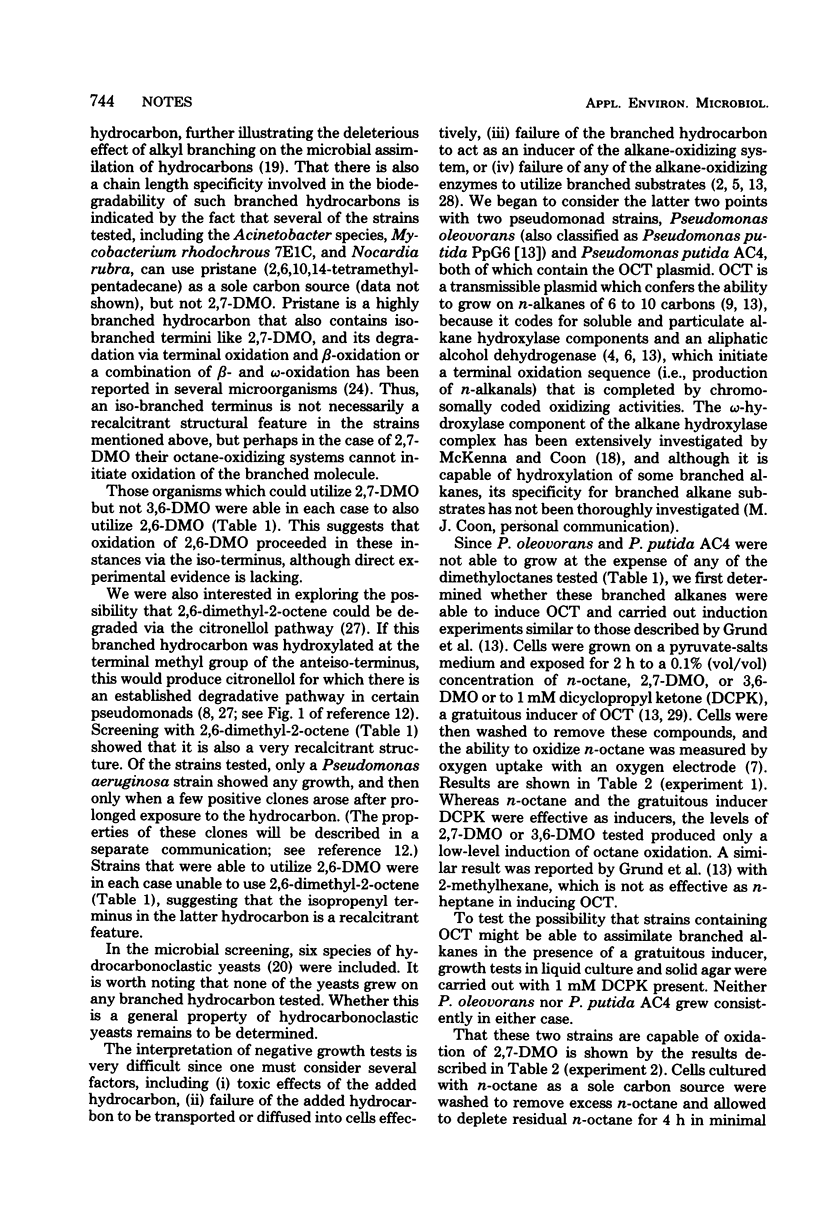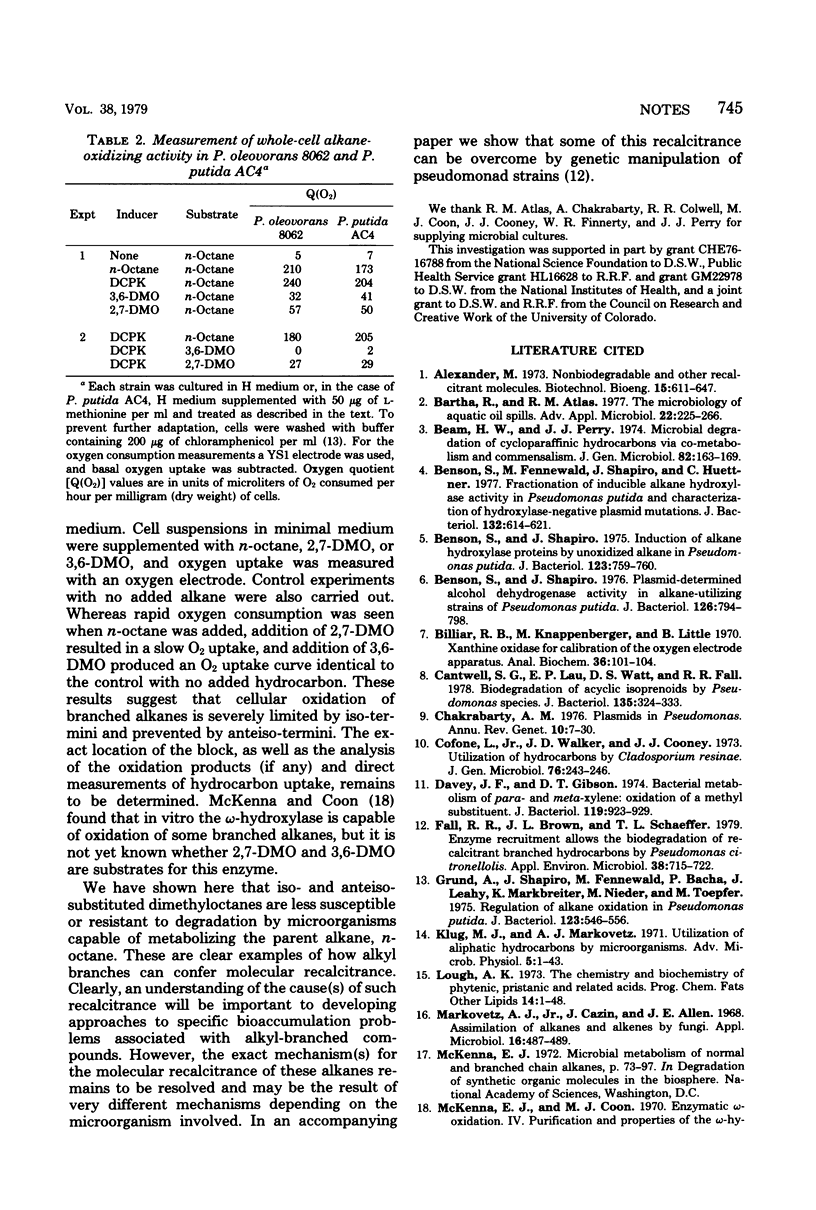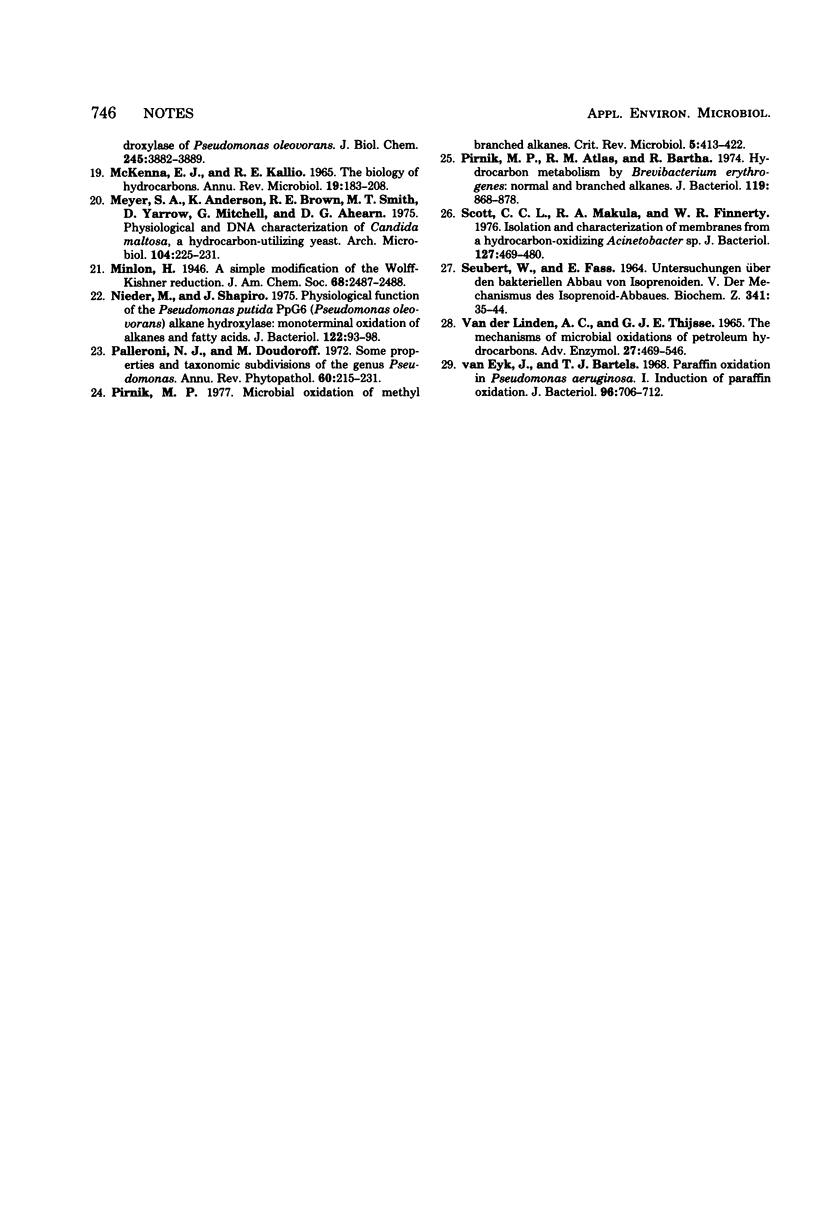Abstract
A variety of octane-utilizing bacteria and fungi were screened for growth on some terminally branched dimethyloctane derivatives to explore the effects of iso- and anteiso-termini on the biodegradability of such hydrocarbons. Of 27 microbial strains tested, only 9 were found to use any of the branched hydrocarbons tested as a sole carbon source, and then only those hydrocarbons containing at least one iso-terminus were susceptible to degradation. Anteiso-or isopropenyl termini prevented biodegradation. None of the hydrocarbonoclastic yeasts tested was able to utilize branched-hydrocarbon growth sustrates. In the case of pseudomonads containing the OCT plasmid, whole-cell oxidation of n-octane was poorly induced by terminally branched dimethyloctanes. In the presence of a gratuitous inducer of the octane-oxidizing enzymes, the iso-branched 2,7-dimethyloctane was slowly oxidized by whole cells, whereas the anteiso-branched 3,6-dimethyloctane was not oxidized at all. This microbial sampling dramatically illustrated the deleterious effect of alkyl branching, especially anteiso-terminal branching, on the biodegradation of hydrocarbons.
Full text
PDF




Selected References
These references are in PubMed. This may not be the complete list of references from this article.
- Bartha R. The microbiology of aquatic oil spills. Adv Appl Microbiol. 1977;22:225–266. doi: 10.1016/s0065-2164(08)70164-3. [DOI] [PubMed] [Google Scholar]
- Benson S., Fennewald M., Shapiro J., Huettner C. Fractionation of inducible alkane hydroxylase activity in Pseudomonas putida and characterization of hydroxylase-negative plasmid mutations. J Bacteriol. 1977 Nov;132(2):614–621. doi: 10.1128/jb.132.2.614-621.1977. [DOI] [PMC free article] [PubMed] [Google Scholar]
- Benson S., Shapiro J. Induction of alkane hydroxylase proteins by unoxidized alkane in Pseudomonas putida. J Bacteriol. 1975 Aug;123(2):759–760. doi: 10.1128/jb.123.2.759-760.1975. [DOI] [PMC free article] [PubMed] [Google Scholar]
- Benson S., Shapiro J. Plasmid-determined alcohol dehydrogenase activity in alkane-utilizing strains of Pseudomonas putida. J Bacteriol. 1976 May;126(2):794–798. doi: 10.1128/jb.126.2.794-798.1976. [DOI] [PMC free article] [PubMed] [Google Scholar]
- Billiar R. B., Knappenberger M., Little B. Xanthine oxidase for calibration of the oxygen electrode apparatus. Anal Biochem. 1970 Jul;36(1):101–104. doi: 10.1016/0003-2697(70)90336-2. [DOI] [PubMed] [Google Scholar]
- Cantwell S. G., Lau E. P., Watt D. S., Fall R. R. Biodegradation of acyclic isoprenoids by Pseudomonas species. J Bacteriol. 1978 Aug;135(2):324–333. doi: 10.1128/jb.135.2.324-333.1978. [DOI] [PMC free article] [PubMed] [Google Scholar]
- Chakrabarty A. M. Plasmids in Pseudomonas. Annu Rev Genet. 1976;10:7–30. doi: 10.1146/annurev.ge.10.120176.000255. [DOI] [PubMed] [Google Scholar]
- Cofone L., Jr, Walker J. D., Cooney J. J. Utilization of hydrocarbons by Cladosporium resinae. J Gen Microbiol. 1973 May;76(1):243–246. doi: 10.1099/00221287-76-1-243. [DOI] [PubMed] [Google Scholar]
- Davey J. F., Gibson D. T. Bacterial metabolism of para- and meta-xylene: oxidation of a methyl substituent. J Bacteriol. 1974 Sep;119(3):923–929. doi: 10.1128/jb.119.3.923-929.1974. [DOI] [PMC free article] [PubMed] [Google Scholar]
- Fall R. R., Brown J. L., Schaeffer T. L. Enzyme recruitment allows the biodegradation of recalcitrant branched hydrocarbons by Pseudomonas citronellolis. Appl Environ Microbiol. 1979 Oct;38(4):715–722. doi: 10.1128/aem.38.4.715-722.1979. [DOI] [PMC free article] [PubMed] [Google Scholar]
- Grund A., Shapiro J., Fennewald M., Bacha P., Leahy J., Markbreiter K., Nieder M., Toepfer M. Regulation of alkane oxidation in Pseudomonas putida. J Bacteriol. 1975 Aug;123(2):546–556. doi: 10.1128/jb.123.2.546-556.1975. [DOI] [PMC free article] [PubMed] [Google Scholar]
- Klug M. J., Markovetz A. J. Utilization of aliphatic hydrocarbons by micro-organisms. Adv Microb Physiol. 1971;5:1–43. doi: 10.1016/s0065-2911(08)60404-x. [DOI] [PubMed] [Google Scholar]
- Lough A. K. The chemistry and biochemistry of phytanic, pristanic and related acids. Prog Chem Fats Other Lipids. 1973;14(1):1–48. doi: 10.1016/0079-6832(75)90001-4. [DOI] [PubMed] [Google Scholar]
- Markovetz A. J., Jr, Cazin J., Allen J. E. Assimilation of alkanes and alkenes by fungi. Appl Microbiol. 1968 Mar;16(3):487–489. doi: 10.1128/am.16.3.487-489.1968. [DOI] [PMC free article] [PubMed] [Google Scholar]
- McKenna E. J., Coon M. J. Enzymatic omega-oxidation. IV. Purification and properties of the omega-hydroxylase of Pseudomonas oleovorans. J Biol Chem. 1970 Aug 10;245(15):3882–3889. [PubMed] [Google Scholar]
- McKenna E. J., Kallio R. E. The biology of hydrocarbons. Annu Rev Microbiol. 1965;19:183–208. doi: 10.1146/annurev.mi.19.100165.001151. [DOI] [PubMed] [Google Scholar]
- Meyer S. A., Anderson K., Brown R. E., Smith M. T., Yarrow D., Mitchell G., Ahearn D. G. Physiological and DNA characterization of Candida maltosa, a hydrocarbon-utilizing yeast. Arch Microbiol. 1975 Aug 28;104(3):225–231. doi: 10.1007/BF00447328. [DOI] [PubMed] [Google Scholar]
- Nieder M., Shapiro J. Physiological function of the Pseudomonas putida PpG6 (Pseudomonas oleovorans) alkane hydroxylase: monoterminal oxidation of alkanes and fatty acids. J Bacteriol. 1975 Apr;122(1):93–98. doi: 10.1128/jb.122.1.93-98.1975. [DOI] [PMC free article] [PubMed] [Google Scholar]
- Palleroni N. J., Doudoroff M., Stanier R. Y., Solánes R. E., Mandel M. Taxonomy of the aerobic pseudomonads: the properties of the Pseudomonas stutzeri group. J Gen Microbiol. 1970 Feb;60(2):215–231. doi: 10.1099/00221287-60-2-215. [DOI] [PubMed] [Google Scholar]
- Pirnik M. P., Atlas R. M., Bartha R. Hydrocarbon metabolism by Brevibacterium erythrogenes: normal and branched alkanes. J Bacteriol. 1974 Sep;119(3):868–878. doi: 10.1128/jb.119.3.868-878.1974. [DOI] [PMC free article] [PubMed] [Google Scholar]
- Pirnik M. P. Microbial oxidation of methyl branched alkanes. CRC Crit Rev Microbiol. 1977 Sep;5(4):413–422. doi: 10.3109/10408417709102812. [DOI] [PubMed] [Google Scholar]
- Scott C. C., Makula S. R., Finnerty W. R. Isolation and characterization of membranes from a hydrocarbon-oxidizing Acinetobacter sp. J Bacteriol. 1976 Jul;127(1):469–480. doi: 10.1128/jb.127.1.469-480.1976. [DOI] [PMC free article] [PubMed] [Google Scholar]
- van Eyk J., Bartels T. J. Paraffin oxidation in Pseudomonas aeruginosa. I. Induction of paraffin oxidation. J Bacteriol. 1968 Sep;96(3):706–712. doi: 10.1128/jb.96.3.706-712.1968. [DOI] [PMC free article] [PubMed] [Google Scholar]
- van der Linden A. C., Thijsse G. J. The mechanisms of microbial oxidations of petroleum hydrocarbons. Adv Enzymol Relat Areas Mol Biol. 1965;27:469–546. doi: 10.1002/9780470122723.ch10. [DOI] [PubMed] [Google Scholar]


